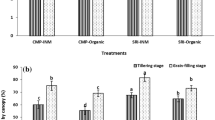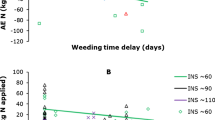Abstract
Rice-based (Oryza sativa L.) rainfed lowlands are the major cropping system in northeast Thailand. Average yields are low, which is generally explained by frequent drought events, low soil fertility, and poor fertilizer response. However, neither the relative importance of these factors nor their interaction is well understood. Therefore, we analyzed an existing database on fertilizer trials conducted between 1995 and 1997 at eight different sites in northeast Thailand with the objective to determine indigenous nutrient supplies, internal efficiencies, and recovery efficiencies of applied nutrients in rainfed lowland rice. Of particular interest was the effect of variety type (traditional) and water supply on these components. Comparison of N, P, and K concentrations in grain and straw (average N–P–K grain concentration of 11.0–2.7–3.4 g kg−1; average N–P–K straw concentration of 5.2–0.9–16.4 g kg−1) in the traditional-type varieties used at all trial sites with literature values showed no differences for these parameters between traditional and modern-type varieties or between irrigated and rainfed environments. In contrast, internal efficiencies of N, P, and K (average IEN: 46 kg grain per kg N uptake; IEP: 218 kg grain per kg P uptake; IEK: 25 kg grain per kg K uptake) were much lower than reported for irrigated systems, and the difference was greatest for K, which is mainly accumulated in the straw. Indigenous nutrient supply (average INS: 38 kg ha−1; IPS: 10 kg ha−1; IKS: 89 kg ha−1) and recovery efficiency (average REN: 0.28 kg kg−1; REP: 0.13 kg kg−1; REK: 0.49 kg kg−1) were low but comparable to the lower values reported from irrigated systems. Average seasonal field water resources seemed to reduce the indigenous nutrient supply but had no or little effect on internal efficiency and recovery efficiency. We concluded that the main reason for the low system productivity without and with fertilizer in northeast Thailand is the dominant use of traditional-type varieties with low harvest indices, which was the dominant cause for the observed low internal nutrient efficiency. Therefore, intensification of rainfed systems through substantially increased nutrient inputs can be recommended only where varieties with an average harvest index of close to 0.4 or higher are available.
Similar content being viewed by others

References
Abao EB Jr, Bronson KF, Wassmann R, Singh U (2000) Simultaneous records of methane and nitrous oxide␣emissions in rice-based cropping systems under rainfed conditions. Nutr Cycl Agroecosyst 58:131–139
Asian Institute of Technology (1978) Water for the northeast: a strategy for the development of small-scale water resources. Vol. 1. Main report. Asian Institute of Technology, Bangkok, Thailand
Bremner JM (1996) Nitrogen-total. In: Sparks DL (eds), Methods of soil analysis. Part 3, Chemical methods. Soil Science Society of America Book Series, Madison, Wis., USA, p 1390
Chantanaparb N, Cholitkul W, Suwanawong S (1976) Fertility of Thai paddy soils. Report on soil chemistry and fertility No. 2, Department of Agriculture, Bangkok, p 113
Dobermann A, Cassman KG, Mammaril CP, Sheehy JE (1998) Management of phosphorus, potassium and sulphur in intensive, irrigated lowland rice. Field Crops Res 56:113–138
Dobermann A, Witt C, Abdulrachman S, Gines HC, Nagarajan R, Son TT, Tan PS, Wang GH, Chien NV, Thoa VTK, Phung CV, Stalin P, Muthukrishnan P, Ravi V, Babu M, Simbahan GC, Adviento MAA (2003) Soil fertility and indigenous nutrient supply in irrigated rice domains of Asia. Agron J 95:913–923
Fukai S (1998) Genotypic variation at low soil fertility in drought-prone rainfed lowland environments. In: Ladha JK, Wade L, Dobermann A, Reichhardt W, Kirk GJD, Piggin C (eds), Rainfed lowland rice: advances in nutrient management research. Proceedings of the International Workshop on Nutrient Management Research in Rainfed Lowlands, October, 1998, Ubon Ratchathani, Thailand. International Rice Research Institute, Manila, Philippines, pp 273–288
Greenland DJ (1997) The sustainability of rice farming. CAB International and International Rice Research Institute (IRRI), Wallingford, UK and Manila, Philippines p 273
Haefele SM, Naklang K, Harnpichitvitaya D, Jearakongman S, Skulkhu E, Romyen P, Phasopa S, Tabtim S, Suriya-arunroj D, Khunthasuvon S, Kraisorakul D, Youngsuk P, Amarante ST, Wade LJ (2006) Factors affecting rice yield and fertilizer response in rainfed lowlands of northeast Thailand. Field Crops Res 98:39–51
Haefele SM, Wopereis MCS(2005) Spatial variability of indigenous N, P, and K supplies and its impact on fertilizer strategies for irrigated rice in West Africa. Plant Soil 274:57–72
Haefele SM, Wopereis MCS, Ndiaye MK, Barro SE, ould Isselmou M (2003) Internal nutrient efficiencies, fertilizer recovery rates and indigenous nutrient supply of irrigated lowland rice in Sahelian West Africa. Field Crops Res 80/1:19–32
Huguenin-Ellie O, Kirk GJD, Frossard E (2003) Phosphorus uptake by rice from soil that is flooded or flooded then drained. Eur J Soil Sci 54:77–90
Jearakongman S, Rajatasereekul S, Naklang K, Romyen P, Fukai S, Skulkhu E, Jumpaket B, Nathabutr K (1995) Growth and grain yield of contrasting rice cultivars under different conditions of water availability. Field Crops Res 44:139–150
Ladha JK, Wade L, Dobermann A, Reichhardt W, Kirk GJD, Piggin C (eds) (1998) Rainfed lowland rice: advances in nutrient management research. IRRI, Los Baños, Philippines, p 297
Limpinuntana V (2001) Physical factors related to agricultural potential and limitations in northeast Thailand. In: Kam SP, Hoanh CT, Trebuil G, Hardy B (eds), Natural resource management issues in the Korat Basin of northeast Thailand: an overview. Proceedings of the planning workshop on ecoregional approaches to natural resource management in the Korat Basin, northeast Thailand, 26–29 Oct., Khon Kaen, Thailand. International Rice Research Institute, Los Baños, Philippines, pp 3–17
Linquist B, Sengxua P (2001) Nutrient management in rainfed lowland rice in the Lao PDR. International Rice Research Institute, Los Baños, Philippines, p 81
Mackill DJ, Coffman WR, Garrity DP (1996) Rainfed lowland rice improvement. IRRI, Los Baños, Philippines, p 242
Maclean JL, Dawe D, Hardy B, Hettel GP (eds) (2002) Rice Almanac IRRI, WARDA, CIAT, FAO, Los Baños (Philippines), Bouaké (Côte d’Ivoire), Cali (Colombia) and Rome (Italy) p 253
OAE (1999) Agricultural statistics of Thailand crop year 1997/98. Center for Agricultural Information, Office of Agricultural Economics. Ministry of Agriculture and Co-operatives. Agricultural Statistics No. 31/1999, Bangkok, Thailand
Oberthuer T, Kam SP (2000) Perception, understanding, and mapping of soil variability in the rainfed lowlands of northeast Thailand. In: Tuong TP, Kam SP, Wade L, Pandey S, Bouman BAM, Hardy B (eds), Characterizing and understanding rainfed environments. Proceedings of the International Workshop on Characterizing and Understanding Rainfed Environments, 5–9 Dec., 1999, Bali, Indonesia. International Rice Research Institute, Los Baños, Philippines, pp 75–96
Pandey S (2001) Economics of lowland rice production in Laos: opportunities and challenges. In: Fukai S, Basnayake J (eds), Increased lowland rice production in the Mekong Region. Proceedings of an International Workshop, 2001, ACIAR Proceedings No. 101, Canberra, Australia, pp 20–30
Pingali PL, Hossain M, Gerpacio RV (1997) Asian rice bowls: the returning crisis? CAB International. Wallingford (UK) p 341
Ragland J, Boonpuckdee L (1987) Fertilizer responses in northeast Thailand: 1. Literature review and rationale. Thai J Soils Fert 9:65–79
Ragland J, Boonpuckdee L (1988) Fertilizer responses in northeast Thailand: 3. Nitrogen use and soil acidity. Thai J Soils Fert 10:67–76
Rosegrant MW, Svendsen M (1993) Irrigation investment and management policy for Asian food production in the 1990s. Food Policy 18:13–32
Seng V, Bell RW, Willet RW, Nesbitt HJ (1999) Phosphorus nutrition of rice in relation to flooding and temporary loss of soil–water saturation in two lowland soils of Cambodia. Plant Soil 2007:121–132
Singh AK, Tuong TP, Wopereis MC S, Boling A, Kropff MJ (1995) Quantifying lowland rice responses to soil-water deficit. In: Fragile lives in fragile ecosystems. Proceedings of the International Rice Research Conference, 13–17 Feb. (1995) Los Baños, Philippines, International Rice Research Institute, pp 507–520
Wade LJ, George T, Ladha JK, Singh U, Bhuiyan SI, Pandey S (1998) Opportunities to manipulate nutrient-by-water interactions in rainfed lowland rice systems. Field Crops Res 56:93--112
Wade LJ, Kamoshita A, Yamauchi A, Azhiri-Sigari T (2000) Genotypic variation in response of rainfed lowland rice to drought and rewatering. I. Growth and water use. Plant Prod Sci 3:173–179
Wade LJ, Amarante ST, Olea A, Harnpichitvitaya D, Naklang K, Wihardjaka A, Sengar SS, Mazid MA, Singh G, McLaren CG (1999a) Nutrient requirements in rainfed lowland rice. Field Crops Res 64:91–107
Wade LJ, McLaren CG, Quintana L, Harnpitchitvitaya D, Rajatasereekul S, Sarawgi AK, Kumar A, Ahmed HU, Sarwoto, Singh AK, Rodriguez R, Siopongco J,␣Sarkarung S 1999b. Genotype by environment interactions across diverse rainfed lowland rice environments. Field Crops Res 64:35–50
Wijnhoud JD, Konboon Y, Lefroy RDB(2003) Nutrient budgets: sustainability assessment of rainfed lowland rice-based systems in northeast Thailand. Agric Ecosyst Environ 100:119–127
Witt C (2003) Fertilizer use efficiencies in irrigated rice in Asia. Proceedings of the IFA Regional Conference for Asia and the Pacific, Cheju Island, Republic of Korea, 6–8 October (2003) [online]. Available at www.fertilizer.org (last update 2003; accessed 27 Sept. 2005). Paris: International Fertilizer Association
Witt C, Dobermann A, Abdulrachman S, Gines HC, Guanghuo W, Nagarajan R, Satawatananont S, Tran Thuc Son, Pham Sy Tan, Le Van Tiem, Simbahan GC, Olk DC (1999) Internal nutrient efficiencies of irrigated lowland rice in tropical and subtropical Asia. Field Crops Res 63:113–138
Yoshida S, Forno DA, Cock JH, Gomez A (1976) Laboratory manual for physiological studies of rice, 3rd edn. International Rice Research Institute, Los Baños, Philippines, p 83
Zeigler RS, Puckridge DW (1995) Improving sustainable productivity in rice-based rainfed lowland systems of South and Southeast Asia. GeoJournal 35(3):307–324
Acknowledgments
Scientists responsible for conducting the trials and data collection at the individual sites were S. Jearakongman, E. Skulkhu, P. Romyen, S. Phasopa, S. Tabtim, D. Suriya-arunroj, S. Khunthasuvon, D. Kraisorakul, and P. Youngsuk. The original data set was produced with support from the Asian Development Bank in the Philippines and the Directorate General for International Cooperation in the Netherlands, with additional support to IRRI from the Department for International Development in the UK. The authors are grateful to the various reviewers for their valuable comments.
Author information
Authors and Affiliations
Corresponding author
Rights and permissions
About this article
Cite this article
Naklang, K., Harnpichitvitaya, D., Amarante, S.T. et al. Internal efficiency, nutrient uptake, and the relation to field water resources in rainfed lowland rice of northeast Thailand. Plant Soil 286, 193–208 (2006). https://doi.org/10.1007/s11104-006-9037-z
Received:
Accepted:
Published:
Issue Date:
DOI: https://doi.org/10.1007/s11104-006-9037-z



